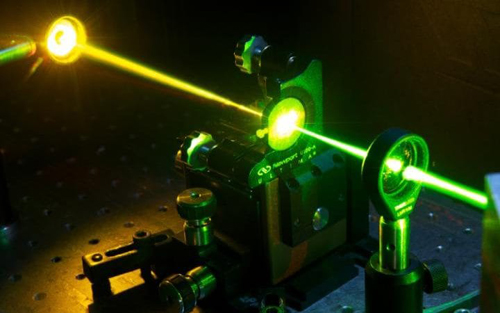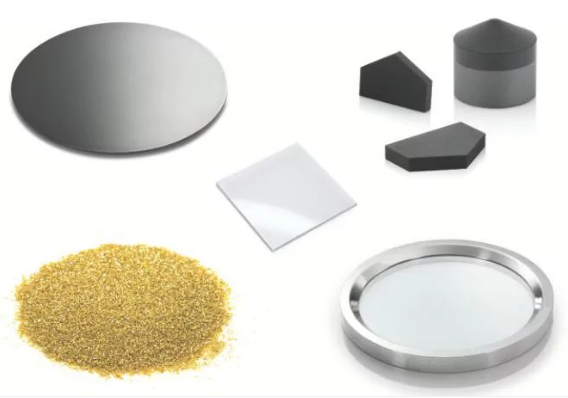
‘Let’s be as creative as we can’, ” says Walter Hühn, chief executive of Element Six. He is describing how the company, based on a technology park near Didcot, encourages its workforce to come up with the best new uses for synthetic diamonds.

Synthetic diamonds enable the use of high-energy lasers
We say to ourselves: ‘let’s be as creative as we can’, ” says Walter Hühn, chief executive of Element Six. He is describing how the company, based on a technology park near Didcot, encourages its workforce to come up with the best new uses for synthetic diamonds.
The high-tech synthetics spawned at E6’s innovation centre in Oxfordshire do not resemble the gemstones in a jeweller’s window; they are more like small, hard CDs. This is because most of E6’s output is geared towards ‘abrasives’, or cutting devices.
“Diamond is the most extreme material known to man,” Hühn says. “It’s technically exciting and very commercially interesting.” Diamond is the hardest material in the world; it is also celebrated for its high-tensile strength and extraordinary thermal conductivity.
By tweaking the atoms at the heart of diamond, E6’s scientists can conjure up synthetics for most industrial purposes, from drill bits in the oil industry to high-energy lasers. “We are sculptors of diamonds,” says Richard Bodkin, research scientist. “Carbon is our raw material.”
The company, which celebrates its 70th anniversary this year, began life as De Beers’ Diamond Research Lab, charged with finding commercial uses for diamonds that were not up to scratch as jewellery. Research into lab-grown diamonds began in the 1950s. De Beers, itself part of Anglo American, is still the majority owner, though Belgium’s Umicore owns 40pc of the abrasives business.
E6 sells its rock-hard product to tool makers who then supply industrial customers. The “effectiveness and precision” of synthetic diamond make it ideal, Hühn explains. “’Synthesis’ is too simple a word – it’s ‘engineered’.”
At Didcot, diamonds are bred in two ways. Giant presses apply vast pressure to a solvent, replicating the forces that forged natural diamonds under the ground. An alternative, low-pressure method is to “print” the diamonds layer by molecular layer in microwave ovens that look like beer kegs.
The innovation centre dates from 2013, and was born out of a desire to group E6’s R&D teams in one place; it also rationalised its manufacturing facilities across the world. The lab occupies the front plot of Harwell Campus, a science park that is home to around 200 organisations. The European Space Agency is across the road, and it is a short walk to the UK’s Synchrotron, which fires electrons at near-light speeds around a ring.
E6 prides itself on a “start-up” ethos; like Google, it allows its staff to use 10pc of their time to work on pet projects. The 180-strong workforce at Harwell includes people from 54 countries and there are free language classes and sports teams. Hühn acknowledges that Brexit “doesn’t make life easier” when it comes to recruitment, but insists Harwell’s location near Oxford is attractive.
While cutting tools are the bread and butter of E6’s work, it is also forging ahead into more exotic areas. Synthetic diamonds are in the race to become the bedrock of quantum computing – a theoretical field that promises massive computational power that eschews the digital technology of “classical” machines.
Quantum computing involves the entanglement of particles in the sub-atomic realm. When one particle becomes ‘entangled’ with another, it synchronises with its partner, even when they have no physical connection. Manipulating one can change the state of the other. Albert Einstein called it “spooky action at a distance”.
Scientists at E6 and Harvard achieved a breakthrough last year when they proved that one particle could alter another 1.3km away without any possible transfer of data between them. “It fundamentally proved this entanglement process is a physical reality - there’s no other explanation for it,” says scientist Matthew Markham.
Yet the properties of diamonds get even weirder. It transpires that diamonds with a ‘nitrogen vacancy defect’ - a gap in the lattice that makes up the crystal - are highly sensitive to magnetic waves at room temperature. The hope is that these diamonds, embedded in handheld scanners, could eventually replace MRI scanners; experiments have already shown that a red diamond can pick up the firing of an axon in the brain of a marine worm. “In 10 years’ time you could envisage having a helmet with diamond sensors that would be the equivalent of MRI sensors,” says Markham.
Scientists also believe that these diamonds could one day use magnetic distortions caused by the sun to triangulate their position on the earth. This would eliminate the need for GPS, which relies on satellite signals to tell a driver where they are; it could also make driverless cars a reality. Currently a diamond with an NV defect has been calibrated to detect the magnetic signature from a car at 300m.
Many of these experiments are decades away from practical applications. But, as Hühn remarks, sometimes they have to “evangelise” about diamonds to create a market for their products. “We need to demonstrate what can be done and then make it transparent to the market,” he says.

Some of E6's products
One example is a diamond tweeter dome developed for manufacturer Bowers & Wilkins. The small dome fits inside a sub-woofer and provides high-clarity sound. E6 had already developed the material before the loudspeaker maker approached it. The invention won a Queen’s Award in 2012.
An area that is strictly off limits is the production of synthetic diamonds for retail - a small but growing part of the jewellery market. De Beers does not wish to put out synthetics that compete with its natural gemstones. Nonetheless De Beers CEO Bruce Cleaver is adamant the miner can learn from E6’s work. “We’re getting them to work with us more and more,” he says. “Technology has to change mining and they have the technology to help us.”
Hühn insists that E6 does not lose sight of its focus amid the blizzard of ideas. Its competitors keep it on its toes - though none of them rival E6 for breadth of projects. “The barrier of entry is quite high,” he says. “The equipment we have is quite expensive, the people we need are quite expensive, and there’s a lot of intellectual property that we’ve built over many years.”
As if to keep it grounded in its more prosaic roots, a large section of the lab is dedicated to breaking up concrete slabs with diamond cutters. Bodkin explains that he will spend a Sunday night in December testing a road-cutting vehicle on the hard shoulder of the M25. “We like our research staff to be involved closely in the final application,” he says. Proof that working with diamonds isn’t all glamour.